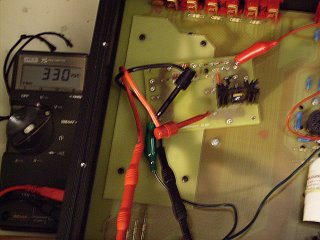 Here is another picture, this time from behind, and with all of the wires in place.
Here is another picture, this time from behind, and with all of the wires in place.There are several major changes. In the front (top of the pic), where the Necromonger heat sink is, the original power supply was upgraded to produce 360V, at 1A if needed.
To the right are the dual mono supplies that take the 360 V and feed each tube 330 independently. Towards the back you can see the red and blue wires (red for Right, of course!) which feed each tube independently, as well as a better picture of the Azuma sockets. I was able to take advantage of unused component holes for these, all I did was enlarge them slightly so I would be able to use enough of the wire to get a solid connection.
The wiring is all Cardas 14 ga. Litz copper wiring. Most of the solder was Cardas, but I admit that some of it, especially for the diodes and resistors, was just Radio Shack silver content solder. I just couldn't wait for the shipment from the Parts Connection to arrive. All resistors are metal film, but not particularly high quality. I did get some Dale/Vishay resistors from Mouser, which were only $0.30 each for the 18k coupling resistor.
The two black wires carry the 360 V from the original regulator stage to the two new stages. There is only one ground wire. This was mostly caused by the fact that I had a really hard time soldering 14 ga. wires with a 40 watt soldering gun. I eventually got the knack of it, but for now, this is how it will have to be. The PCB was designed for this from the start, and will help keep the star grounding method of the original board.









